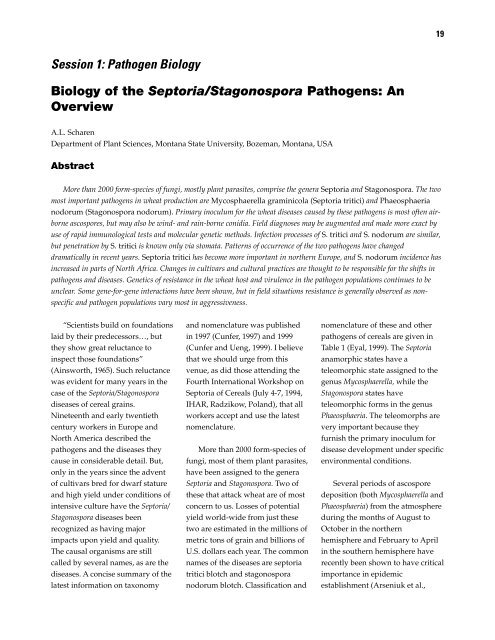Septoria and Stagonospora Diseases of Cereals - CIMMYT ...
Septoria and Stagonospora Diseases of Cereals - CIMMYT ...
Septoria and Stagonospora Diseases of Cereals - CIMMYT ...
You also want an ePaper? Increase the reach of your titles
YUMPU automatically turns print PDFs into web optimized ePapers that Google loves.
Session 1: Pathogen Biology<br />
Biology <strong>of</strong> the <strong>Septoria</strong>/<strong>Stagonospora</strong> Pathogens: An<br />
Overview<br />
A.L. Scharen<br />
Department <strong>of</strong> Plant Sciences, Montana State University, Bozeman, Montana, USA<br />
Abstract<br />
More than 2000 form-species <strong>of</strong> fungi, mostly plant parasites, comprise the genera <strong>Septoria</strong> <strong>and</strong> <strong>Stagonospora</strong>. The two<br />
most important pathogens in wheat production are Mycosphaerella graminicola (<strong>Septoria</strong> tritici) <strong>and</strong> Phaeosphaeria<br />
nodorum (<strong>Stagonospora</strong> nodorum). Primary inoculum for the wheat diseases caused by these pathogens is most <strong>of</strong>ten airborne<br />
ascospores, but may also be wind- <strong>and</strong> rain-borne conidia. Field diagnoses may be augmented <strong>and</strong> made more exact by<br />
use <strong>of</strong> rapid immunological tests <strong>and</strong> molecular genetic methods. Infection processes <strong>of</strong> S. tritici <strong>and</strong> S. nodorum are similar,<br />
but penetration by S. tritici is known only via stomata. Patterns <strong>of</strong> occurrence <strong>of</strong> the two pathogens have changed<br />
dramatically in recent years. <strong>Septoria</strong> tritici has become more important in northern Europe, <strong>and</strong> S. nodorum incidence has<br />
increased in parts <strong>of</strong> North Africa. Changes in cultivars <strong>and</strong> cultural practices are thought to be responsible for the shifts in<br />
pathogens <strong>and</strong> diseases. Genetics <strong>of</strong> resistance in the wheat host <strong>and</strong> virulence in the pathogen populations continues to be<br />
unclear. Some gene-for-gene interactions have been shown, but in field situations resistance is generally observed as nonspecific<br />
<strong>and</strong> pathogen populations vary most in aggressiveness.<br />
“Scientists build on foundations<br />
laid by their predecessors…, but<br />
they show great reluctance to<br />
inspect those foundations”<br />
(Ainsworth, 1965). Such reluctance<br />
was evident for many years in the<br />
case <strong>of</strong> the <strong>Septoria</strong>/<strong>Stagonospora</strong><br />
diseases <strong>of</strong> cereal grains.<br />
Nineteenth <strong>and</strong> early twentieth<br />
century workers in Europe <strong>and</strong><br />
North America described the<br />
pathogens <strong>and</strong> the diseases they<br />
cause in considerable detail. But,<br />
only in the years since the advent<br />
<strong>of</strong> cultivars bred for dwarf stature<br />
<strong>and</strong> high yield under conditions <strong>of</strong><br />
intensive culture have the <strong>Septoria</strong>/<br />
<strong>Stagonospora</strong> diseases been<br />
recognized as having major<br />
impacts upon yield <strong>and</strong> quality.<br />
The causal organisms are still<br />
called by several names, as are the<br />
diseases. A concise summary <strong>of</strong> the<br />
latest information on taxonomy<br />
<strong>and</strong> nomenclature was published<br />
in 1997 (Cunfer, 1997) <strong>and</strong> 1999<br />
(Cunfer <strong>and</strong> Ueng, 1999). I believe<br />
that we should urge from this<br />
venue, as did those attending the<br />
Fourth International Workshop on<br />
<strong>Septoria</strong> <strong>of</strong> <strong>Cereals</strong> (July 4-7, 1994,<br />
IHAR, Radzikow, Pol<strong>and</strong>), that all<br />
workers accept <strong>and</strong> use the latest<br />
nomenclature.<br />
More than 2000 form-species <strong>of</strong><br />
fungi, most <strong>of</strong> them plant parasites,<br />
have been assigned to the genera<br />
<strong>Septoria</strong> <strong>and</strong> <strong>Stagonospora</strong>. Two <strong>of</strong><br />
these that attack wheat are <strong>of</strong> most<br />
concern to us. Losses <strong>of</strong> potential<br />
yield world-wide from just these<br />
two are estimated in the millions <strong>of</strong><br />
metric tons <strong>of</strong> grain <strong>and</strong> billions <strong>of</strong><br />
U.S. dollars each year. The common<br />
names <strong>of</strong> the diseases are septoria<br />
tritici blotch <strong>and</strong> stagonospora<br />
nodorum blotch. Classification <strong>and</strong><br />
19<br />
nomenclature <strong>of</strong> these <strong>and</strong> other<br />
pathogens <strong>of</strong> cereals are given in<br />
Table 1 (Eyal, 1999). The <strong>Septoria</strong><br />
anamorphic states have a<br />
teleomorphic state assigned to the<br />
genus Mycosphaerella, while the<br />
<strong>Stagonospora</strong> states have<br />
teleomorphic forms in the genus<br />
Phaeosphaeria. The teleomorphs are<br />
very important because they<br />
furnish the primary inoculum for<br />
disease development under specific<br />
environmental conditions.<br />
Several periods <strong>of</strong> ascospore<br />
deposition (both Mycosphaerella <strong>and</strong><br />
Phaeosphaeria) from the atmosphere<br />
during the months <strong>of</strong> August to<br />
October in the northern<br />
hemisphere <strong>and</strong> February to April<br />
in the southern hemisphere have<br />
recently been shown to have critical<br />
importance in epidemic<br />
establishment (Arseniuk et al.,









